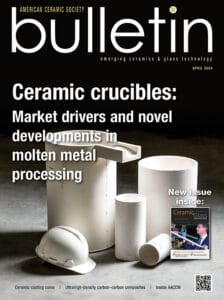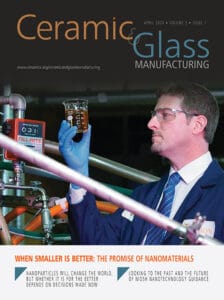GOMD 2018 Award lecture abstracts
George W. Morey award
The architectured glass
Himanshu Jain, T.L. Diamond Distinguished Chair in Engineering and Applied Science and Professor of Materials Science and Engineering, Lehigh University, USA
Glass is most widely known to consumers as a transparent, hard solid; to artists and manufacturers as the material that can be formed into most complex shapes by a variety of thermal processes; and to glass scientists as an ever-relaxing metastable material. A combination of these unique characteristics offers opportunities to selectively design i.e. architecture the structure, hence the properties, of glass, which would be nearly impossible to accomplish in any other class of material. Furthermore, an architectured glass can exhibit active functionality in an otherwise inactive matrix. Such developments pave the way for transforming microelectronic chip into an integrated photonic chip made of optical circuits with multiple functionalities; for a novel grayscale photoresist; for lab-on-a-chip with multiple diagnostic tools; etc. We will explore the development of this paradigm for expanding the application space of glass, based on the fundamental understanding of the structural evolution under external stimuli (light, electron beam, temperature, electric field, mechanical stress, etc.). Examples from author’s lab as well as from the literature will show that a stimulus can drive the structure toward the most stable single crystal state, or a less stable state with electronic and atomic defects, thus allowing a great degree of freedom for tuning the properties, even in opposite directions. Prospects and challenges of architectured glass for the future will be presented.
Stookey Lecture of Discovery
Bulent Yoldas
Formation of glass and ceramics by chemical polymerization and its effects on properties
Almost any type of oxide glass or ceramics can be made by non-thermal chemical reactions of metal organic compounds. At the heart of this process is the capability of metal alkoxides to form oxide networks by hydrolytic poly-condensation reactions at room temperature. This condensates then can be reduced to pure oxides around 500°C. The morphology and the stoichiometry of the resultant networks are subject to significant manipulation which allows one to introduce a spectrum of configuration variation. These variations show a surprising stability at high temperatures and a significant effects on the thermoplastic and photonic properties.
In this presentation, the genesis and nature of the differences between the chemical and thermal formation of oxide networks as well as their effects on properties will be discussed.
Norbert J. Kreidl Award for Young Scholars
Surface stress relaxation of silica glass and the presence of composition fluctuations
Emily Aaldenberg, Rensselaer Polytechnic Institute, USA
Small amounts of water in the atmosphere have the ability to promote fast relaxation of surface stress as the water diffuses into the glass. This surface stress relaxation has been found to be responsible for the fatigue limit, degradation of the ion-exchanged glass compressive stress profile, and strengthening of thin glass fibers, including silica glass fibers. Until this point, models for surface stress relaxation have assumed the stress to reduce in a surface layer, but the cause of this stress reduction remained a mystery. We propose that water in glass creates composition fluctuations which lead to a reduction in the modulus of the water-rich layer and the presence of delayed elastic relaxation behavior. This presentation will focus on the presence of composition fluctuations between water and glass through three experiments: small angle x-ray scattering, the memory effect, and the formation of bubbles at low temperature.
Varshneya Glass Science lecture abstract:
Mechanics, chemistry, and light: The photoelasticity of glass
Josef Zwanziger, Dalhousie University, Dept. of Chemistry, Halifax, NS, CAN
Application of mechanical stress to glass causes interesting changes in how it transmits light. This interplay is summarized by the elasto-optic tensor, the key metric for technological applications including zero stress-optic glass, and reduced stimulated Brillouin scattering glass. Fundamentally, these effects are controlled by the glass chemistry, and in particular the nature of the chemical bonds that make up the glass. We will summarize our approach to this problem, which is focused on both an empirical and ab initio approach to the structure-property relations governing the elasto-optic tensor. We will describe the control of the stress-optic response through judicious choice of glass chemistry, and also describe our current progress in understanding and developing glass with reduced stimulated Brillouin scattering. We will include discussion of both average properties and energy-dispersive effects. We will show how these effects may be computed ab initio, with a reasonable trade-off between accuracy and speed, and illustrate a bond-based model we are developing that attempts to put in simple terms the empirical relations we have discovered.
Varshneya Glass Technology lecture
Structure-property relationships in halide containing bioactive glasses
Robert Hill, Imperial College, DPS, London, UK
This talk will discuss structure-property relationships in Fluorine and Chlorine containing bioactive glasses. This will include the use of 29Si, 31P and 19F solid state NMR spectroscopy to elucidate the detailed chemical structure of these bioactive glasses. It will be shown how a structural understanding of the role of phosphorus and the halide in conjunction with Network Connectivity (NC) calculations can be used to predict dissolution rates/bioactivity as well as other properties such as refractive index and hardness. Phosphrus exists largely as orthophosphate species, whilst F anf Cl exist as F-M(n) species. Network connectivity plays an important role in determining dissolution rates and the abilty of the glass to form apatite (bioactivity). Both fluoride and chloride ions are released along with Ca2+ and PO43- ions and in the case of fluoride containing glasses fluorapatite is formed upon immersion.
The design of glasses suitable: i) for re-mineralizing toothpastes, ii) for self repairing dental fillings and iii) for air abrasives for cutting or polishing teeth will be outlined.
The talk will then discuss in depth the two toothpastes BioMinF® - based on a fluoride based bioactive glass and BioMinC® - a chloride based bioactive glass.




